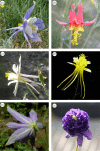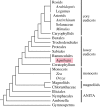Aquilegia as a model system for the evolution and ecology of petals
- PMID: 20047874
- PMCID: PMC2838260
- DOI: 10.1098/rstb.2009.0230
Aquilegia as a model system for the evolution and ecology of petals
Abstract
The ranunculid genus Aquilegia holds extraordinary promise as a model system for investigating a wide range of questions relating to the evolution and ecology of petals. New genetic and genomic resources, including an extensive EST database, BAC libraries and physical maps, as well as virus-induced gene silencing are facilitating this research on multiple fronts. At the developmental genetic level, Aquilegia has been important for elucidating the developmental programme for specifying petals and petaloid characteristics. Data suggest that duplication events among the petal and stamen identity genes have resulted in sub- and neofunctionalization. This expansion of gene function does not include the petaloidy of Aquilegia sepals, however, which does not depend on the same loci that control identity of the second whorl petals. Of special interest is the elaboration of the petal into a nectar spur, a major innovation for the genus. Intra- and interspecific variation in the shape and colour of petals, especially the spurs, has been shown to be adaptative for different pollinators. Thus, understanding the genetic basis of these traits will help us connect the ecological interactions driving speciation with the genetic changes responsible for remodelling morphology. Progress in this area has focused on the multiple, parallel transitions in flower colour and nectar spur length across the genus. For flower colour, upstream transcription factors appear to be primarily targets of natural selection. Thus research in Aquilegia spans the initial evolution of petals and petaloidy to the diversification of petal morphology to the ecological basis of petal form, thereby providing a comprehensive picture of the evolutionary biology of this critical angiosperm feature.
Figures






References
-
- Abouheif E., Akam M., Dickinson W. J., Holland P. W. H., Meyer A., Patel N. H., Raff R. A., Roth V. L., Wray G. A.1997Homology and developmental genes. Trends Genet. 13, 432–433 (doi:10.1016/S0168-9525(97)01271-7) - DOI - PubMed
-
- Abzhanov A., Extavour C. G., Groover A., Hodges S. A., Hoekstra H. E., Kramer E. M., Monteiro A.2008Are we there yet? Tracking the development of new model systems. Trends Genet. 24, 353–360 (doi:10.1016/j.tig.2008.04.002) - DOI - PubMed
-
- APG 2003An update of the Angiosperm Phylogeny Group classification for the orders and families of flowering plants: APG II. Bot. J. Linn. Soc. 141, 399–436 (doi:10.1046/j.1095-8339.2003.t01-1-00158.x) - DOI
-
- Baum D. A., Whitlock B. A.1999Genetic clues to petal evolution. Curr. Biol. 9, 525–527 - PubMed
-
- Becker A., Theissen G.2003The major clades of MADS-box genes and their role in the development and evolution of flowering plants. Mol. Phylogenet. Evol. 29, 464–489 (doi:10.1016/S1055-7903(03)00207-0) - DOI - PubMed
Publication types
MeSH terms
LinkOut - more resources
Full Text Sources
Research Materials

